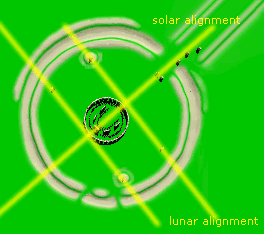Stonehenge
Astronomical Alignemnts
The midsummer sun always rises exactly opposite the setting of the midwinter sun - thus an alignment with one is an alignment with the other, unless some feature blocks one of the alignments. Everyone knows that Stonehenge is aligned so that the Sun rises above the Heel stone as viewed from inside the stones...
It doesn't - quite. All those lovely photographs showing the midsummer sun rising above the Heel stone are a con trick - the sun has already risen and is part of the way on in its journey round the sky. However, the Heel stone had a partner, and when this was still standing, the midsummer sun would have been framed by this pair of standing stones as the first rays of dawn shone through a stone corridor into the heart of Stonehenge.
Wait six months and what was perhaps a more important event comes to pass. The days have grown shorter and the air cooler, and at the Winter Solstice the midwinter sun sets, framed between the uprights of the Great Trilithon, This is the shortest day (21 December) and after this the days will grow longer.
Midwinter is the time when ceremonial help is most necessary - the Sun, giver of life, has been growing weaker every day. It is the Winter solstice when things turn around, and the Sun grows stronger once again.
The Moon has been important to many prehistoric societies, and in particular the extremes of moonrise and moonset. The rising and setting of the moon follows a complex pattern which repeats ever 18.6 years. The Station Stones are aligned in the direction of the northernmost moonset at the 'major standstill' and also the southernmost moonrise at the major standstill.

right angle crossing of alignments
At the latitude of Stonehenge, this axis crosses the midwinter sunset/midsummer sunrise axis at right-angles. This relationship is only possible at around the latitude of Stonehenge - it may well have been significant in the siting of the circle.
Proving alignments can be difficult for two reasons. One is that with several objects and enormous number of alignments is possible by drawing a straight line through two of the objects. These occur randomly - to infer a deliberate alignment you have to prove that it is unlikely to have appeared by chance.
Then there is the required accuracy of alignment, which isn't helped by the fact that the physical objects (the stones) may have been moved slightly over the years. And the posision of the stars themselves moves around the horizon due to small variations in the Earth's orbit around the sun.
All of this makes life difficult for archaeo-astronomers. Some have used the variation in position of the stars over the millennia to try and date structures - but tiny physical movements can make such datings shoot back or forwards in time by centuries.
Astronomical alignments at Stonehenge have caused some controversy. Whilst the solar alignment is not particularly contested, other theories are. In 1966 an American Gerald Hawkins published his book Stonehenge Decoded in which he used an IBM computer to look for astronomical alignments and developed a coarse eclipse predictor using some of the features. This book caused a considerable stir - though the computer probably had a tiny fraction of the power of the machine you are reading this on it was at a time when the power of the computer to process data seemed almost magical. It blinded readers to some some execrable methodology, for instance, using the Station Stones and the Aubrey Holes despite the fact that some of the latter are covered by the Station Stones so they could not have both been used at the same time.
Nevertheless other people since then have taken greater care, and the field of relating astronomical alignments to archaeology is now called archaeo-astronomy. John North's book "Stonehenge - Neolithic Man and the Cosmos" covers the subject in excellent detail.